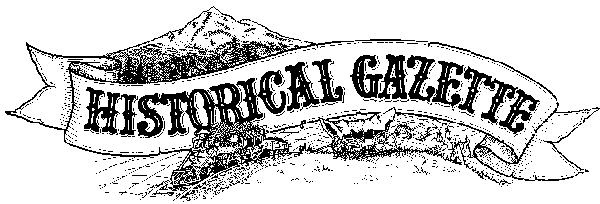Oregon: Land of Gold and Opportunity
Volume Two Number Seven
Oregon Trail 1873
Gold Brings Immigration Civilization Soon Follows "Not enough gold has yet been found to repay the labor of procuring it," wrote Major Benjamin Alvord, in 1853. (ed. note: Alvord became the brigadier general of the volunteers for the District of Oregon in 1863).
Many prospectors are busy along the waters of Columbia River and on both sides of the Canadian boundary. Reports of gold in Thompson and Fraser rivers, in 1856-57, produced the great "rush" of 1858 to those streams. Gold- seeking thence spread over British Columbia, and a great development of mining took place in that province in 1860-70. The Idaho mines began activities in 1860, those of John Day and Powder River, in Eastern Oregon, in 1861; those of Montana, in 1862.
It may thus be seen that the search for the precious metal on the Pacific Coast was, and is, a general and wide movement, continuing many years. Oregon's part in this movement was not detached, either in time or method. When Willamette Valley farmers went "stampeding" to the mines of Clearwater, Salmon River, Boise, Owyhee and John Day, thousands of others were going thither also, from many parts of the world, and to Eastern Washington, Montana and British Columbia.
The pioneers of Willamette Valley and Cowlitz and Puget Sound hardly stopped to think of the immensity of the gold movement. And it may be added that it included, also, Nevada and Colorado. In topography, industry, transportation, politics, the results were far-reaching.
Prospectors explored every river, mountain, lake and plain. They toiled along all the streams and over the intervening ridges. They learned the contours, the possible routes of trade, the lands available for tillage. They were the advance agents of the succeeding farmers, merchants and transportation men, the geodetic surveyors of their time. The remote sources of the Rogue, Umpqua, Willamette, Columbia and Fraser rivers were their objectives. Their needs and those of the miners located trade centers and routes of traffic, and caused the growth of cities.
Jacksonville, Scottsburg, Crescent City, Yreka, became the leading supply points in Southern Oregon and Northern California. Portland soon leaped into preeminence, as the metropolis of the region. The population of Portland more than doubled from 1280 in 1857, to 2917 in 1860. It grew to 6000 in 1865 and to 9565 in 1870.
The primitive life of the Oregon pioneers prior to the gold movement; the isolation, the remoteness from currents of the world and the Nation; the hardships of family existence; the absence of the comforts of the later day; the lack of markets and the narrow range of industry. The gold movement began the evolution of varied industry, and the later growth of the country.
The value of the gold treasure, extracted from the rocks and earth of the interior region of the Pacific Northwest and Montana, was very large in the then undeveloped condition of this region. In the best years (1861-67), the treasure amounted to $20,000,000 in gold a year, or $140,000,000 for the period. Before the gold period, which began in 1858-60, the region was the most remote, and had the scantiest white population of any part of the Nation.
News from the Eastern centers was four to six weeks old when it reached Portland, Oregon, by way of the California overland stage route, and thence by ocean steamship northward. The mails came to Portland by sea twice a month. The admission of Oregon as a state, February 14, 1859, became known in Oregon a month afterwards.
The earlier gold activities, that began in California in 1848, stimulated affairs of the North Pacific Coast. The Willamette Valley and Puget Sound then found the markets opening for farm products and lumber. Money became abundant and prices soared. Fertile areas in the interior grew in usefulness and productivity, with mining development. The valley of the Walla Walla was one of the earliest localities in this work, beginning in 1858-59. The livestock industry grew ahead of farming in the interior country. ~Leslie M. Scott compiler of Harvey Scott's History of the Oregon Country extracted by Bridget E. Smith, editor of the Historical Gazette
The story above is from the front page of this edition. Other titles included in our hard copy: Flour Trade Booming, Prize Livestock Imported and a story about the beginnings of the Oregon Historical Society.
Continue the Oregon Trail saga! Read our Number Eight of the series, Oregon Trail 1877 Chief Joseph Surrenders to Col. Miles
Digging for more gold stories?
[Sumpter, Oregon 1900 | Baker City, 1899 | Dequille reports on the Comstock]
[Gold Seekers Rush to California, Oregon Trail 1849]

Bridget E. Smith, editor & publisher
Email | Home Page | Historic Headlines
Historical Gazette
Published in Portland, Oregon
© 1991-


